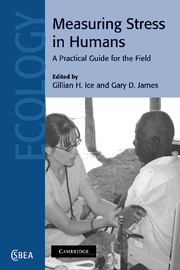Book contents
- Frontmatter
- Contents
- Contributors
- Foreword by Geoffrey A. Harrison
- Part I General principles
- Part II Measuring stress responses
- Part III Practical issues in studying stress
- 8 Measuring stress in special populations
- 9 Study design and data analysis
- 10 Protection of human subjects in stress research: an investigator's guide to the process
- 11 Epilog: summary and future directions
- Index
- References
9 - Study design and data analysis
Published online by Cambridge University Press: 11 September 2009
- Frontmatter
- Contents
- Contributors
- Foreword by Geoffrey A. Harrison
- Part I General principles
- Part II Measuring stress responses
- Part III Practical issues in studying stress
- 8 Measuring stress in special populations
- 9 Study design and data analysis
- 10 Protection of human subjects in stress research: an investigator's guide to the process
- 11 Epilog: summary and future directions
- Index
- References
Summary
Stress implies that a physiological or psychological change has occurred within a subject or that, because of a broader ecological stressor, measurable biological differences between subjects or groups of subjects exist. A variety of study designs can be employed to detect the effects of stress on biology and behavior in the field, although these variants fall under two general categories: 1) natural experiments with an a priori ecological framework and 2) model building or testing where there is no ecological framework per se, but rather a framework of expected relationships based on the results of prior field and/or laboratory research. Depending upon whether a field study of stress is designed to evaluate individual change or group differences, single or multiple measurements per subject can be evaluated.
The purpose of this chapter is to discuss, from a practical standpoint, research design and analytic approaches and techniques that are useful for field studies of stress. The intent is to provide researchers with information on how to develop a meaningful stress study and, hopefully, some insight into how best to evaluate stress-related data. It is not the intent of this chapter to detail specific statistical procedures; however, we will, when necessary, make reference to them.
Research design and the constraints of data collection
In conducting any study of stress response in the field (outside the laboratory), it is best to proceed with a plan in mind, one that will guide not only what data will be collected, but also one that is tied to the analytic technique (statistics) that will be used to test the study hypotheses.
- Type
- Chapter
- Information
- Measuring Stress in HumansA Practical Guide for the Field, pp. 226 - 245Publisher: Cambridge University PressPrint publication year: 2006



